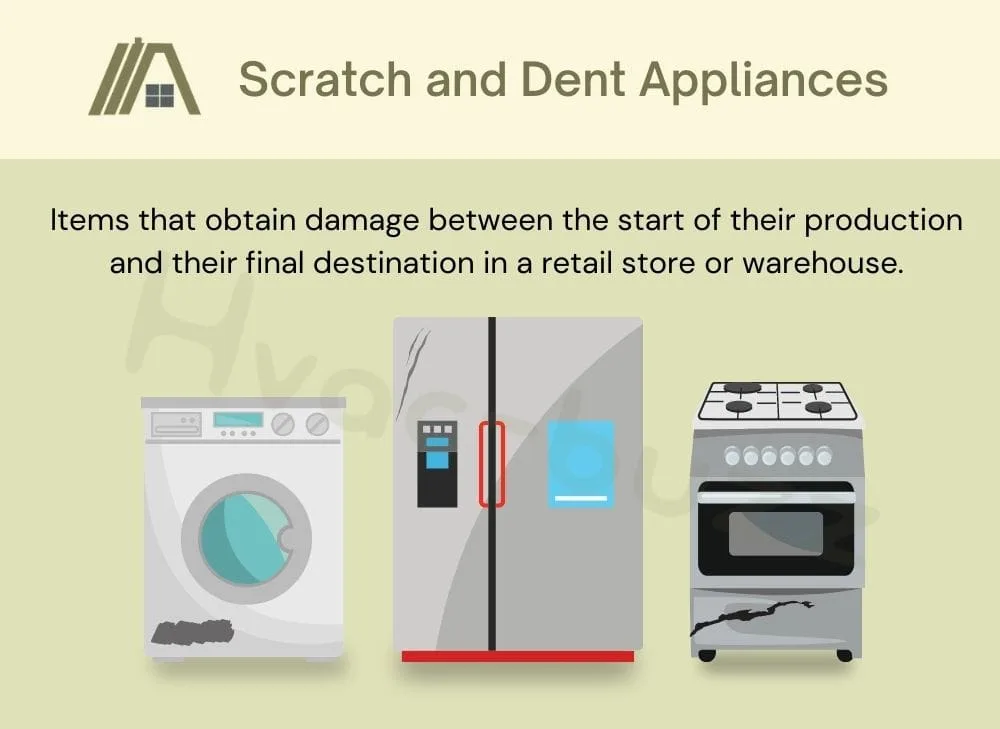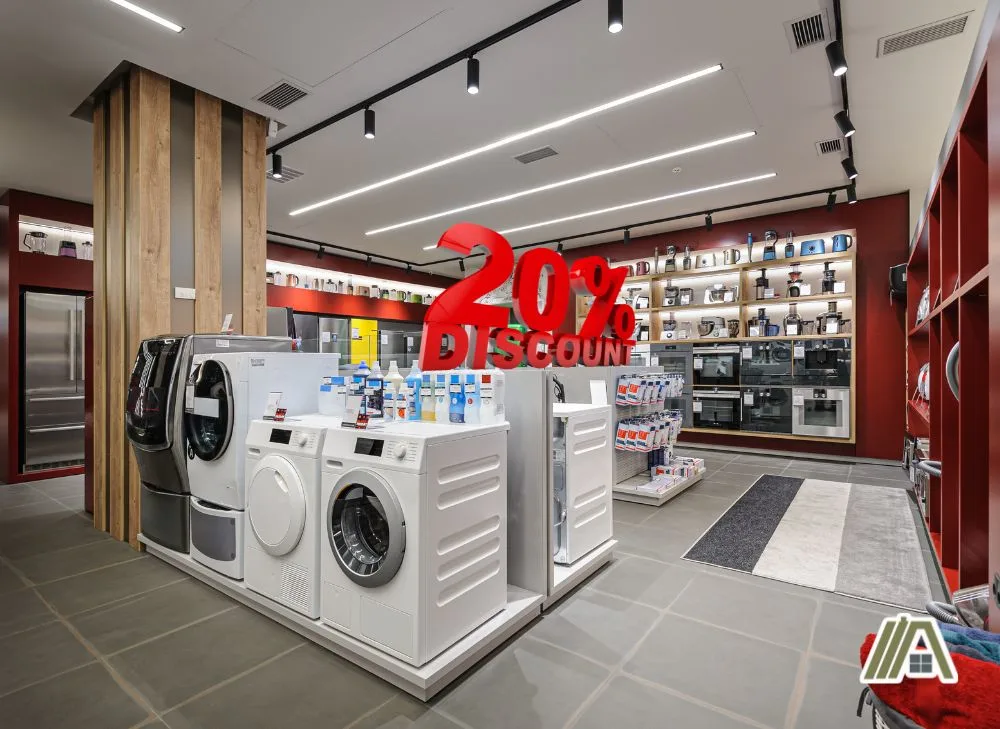If you are a bargain hunter like many savvy individuals, then scratch and dent discounts are your pot of gold. The ability to fill a home with high-performing appliances for below-budget prices—who would turn that down?
But how far below budget the prices will go depends on a few factors. Let’s investigate how these discounts fluctuate and if there is wiggle room for negotiating the best price.

In general, scratch and dent discounts can range between 15-50%. Higher than 60% is rare, and lower than 10% may not be worthwhile. The discount depends on the extent of damage, how long the item remains unsold, who is selling the item, and what it is.
What Are Scratch and Dent Appliances?
To begin, scratch and dent appliances are items that obtain damage between the start of their production and their final destination in a retail store or warehouse.

The most important thing to know about these appliances is that while they do have some sort of external, aesthetic issue, their functionality is not impaired in any way.
Companies make this distinction so that customers may pay a reduced price for items that are damaged, but not unusable.
Some appliances that you can find at scratch and dent prices include ovens, AC units, refrigerators, dehumidifiers, microwaves, range hoods, and more.
Common Causes of the Cosmetic Damage
One of the common ways that scratch and dent appliances receive their damage is during the shipping process.
These damages can occur from impact with surfaces during transport, as well as from the vibrations of cars, trains, and other transportation methods used for shipping.
Damages can also occur to appliances while they are being handled, stored, and distributed in warehouses.
This can happen due to items being dropped, stored improperly, or mishandled in some way. It can also occur if storage palettes in a warehouse are damaged or are not stacked properly.
Finally, it can still be considered cosmetic damage even if damage only occurs to the packaging or label of a product rather than to the product itself.
If the box, label, or container for an appliance is badly damaged, retailers will remove the packaging and sell it for a scratch and dent price even without any damage to the actual appliance.
Who Sells Scratch and Dent Appliances?
Scratch and dent appliances are typically sold by third-party retailers and websites rather than by manufacturers.
It may come as a surprise to you that many well-known retail chains commonly have scratch and dent appliances available online and/or in stores. This includes companies such as Lowe’s, Home Depot, Best Buy, Sears Outlet, and more.
You may also be able to find scratch and dent appliances at small, local appliance stores. It’s worth checking if there are any such places in your area and seeing what they offer.
Some places will have a section dedicated to these appliances, while others may offer solely scratch and dent appliances.
Finally, scratch and dent appliances can also be found online on third-party retail websites (example). When using these sites, make sure to do thorough research to ensure that they are reputable.
Average Scratch and Dent Discount
It can be difficult to provide an average discount for scratch and dent appliances because of all the factors that can influence the appliance’s price.
However, it will range between 15% to about 50%. Some devices may even be discounted up to 60%. Higher than this is very rare. Lower than 10% might not be worth it.
Factors That Determine Discount
Extent of Damage
Now, all scratch and dent appliances only have cosmetic damage, which should not interfere with function.
So, when we are talking about the extent of the damage, we mean how many dings, dents, or scratches are on the external surface or how big they are.
A small scratch or two won’t likely get you more than a 20% discount. But anything more than that will get you more off.

While none of the items can be sold as brand new, the manufacturers or third-party sellers know that people are more likely to buy items with less damage, so they give smaller discounts to increase their losses.
Before you buy a heavily discounted item, make sure that you are willing to live with the damage or that you have a way of covering or repairing it. You don’t want a repaired scratch and dent fridge that ends up costing the same as a brand new, mint-condition one would have.
How Long the Product Remains Unsold
The longer an item sits in a store unsold, the more likely the sellers are going to lower the price.
The retailer would prefer to utilize their floor space for newer appliances and would find it easier to lower the price to get rid of unwanted stock, especially if it is for an item that is not in high demand.
It is better to sell the item at a much lower price than to not sell it at all and pay for ongoing holding costs.
In addition, the longer a retailer keeps unwanted stock the more outdated appliances become and people are more interested in purchasing more modern models as it may be easier to purchase parts for them and repair them in the future.
Where You Buy the Item
Generally, scratch and dent appliances and furniture are sold by third-party retailers and not the manufacturers themselves. The applied discount can vary between retailers and cities.
So, location plays a huge role in what the retailer will be to take for an item.
If the items are priced to high for the economic class that patronizes the store, then the retailed is not going to make any money. Rather discount the scratch and dent appliance enough to be affordable for the people. That way, the retailer is guaranteed to make money.
This is less likely for chain retailers, however, as discounts need to be as consistent as possible in such stores.
Smaller and independent retailers with fewer overheads may be able to offer larger discounts. Even online retailers may provide higher discounts for the same reasons.

What the Item is
If the item is a popular brand, the discount on the item may not be as low as an item that isn’t as sought-after.
People may end up paying the same for these as they would for a new, less high-end appliance, but they will be able to say that they have the high-end one.
Then there is also the matter of what the appliance is. Everyone uses a fridge but not everyone will be interested in a stationary bicycle.
Are the Prices Negotiable?
In some stores, the prices can be negotiable. Chain retailers are not your best bet. Rather aim for the independent stores.
Stores that pay their staff on commission could be more open to negotiation or less. It really depends on how many sales they need to make, how close they are to their target, and even how popular the item is.
If they are really close to their target and your low-ball offer will help them hit it, they may reduce the price. You are less likely to succeed if you are trying to barter for the high-end piece that they are relying on to kickstart them on their sales targets.
Sources
https://www.cnet.com/home/kitchen-and-household/buy-scratch-and-dent-appliances/
https://techbullion.com/how-much-are-dented-appliances-discounted/
https://www.spencerstv.com/blog/scratch-and-dent-appliances
https://www.houzz.com/discussions/4875606/fridge-arrived-dented-what-is-a-fair-discount
https://homeguides.sfgate.com/dented-scratched-appliances-99102.html
